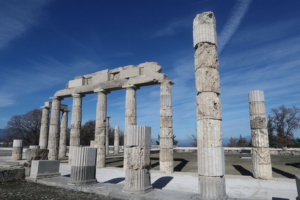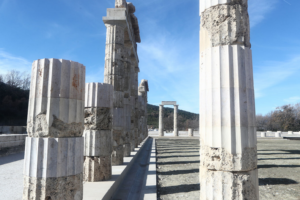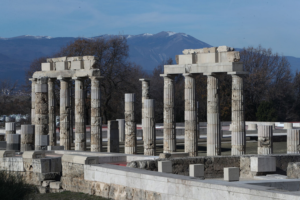The Greek Prime Minister Kyriakos Mitsotakis began his visit to the region from Meliki, Imathia ahead of the ceremony for the inauguration of the restored palace of Philip II, the so-called “Parthenon of Macedonia” with the Prime Minister pointing out that it is a project that “has not only a cultural but also a national character as it confirms the timeless Greekness of Macedonia throughout the centuries and turns the region into a cultural pole, I dare say of global scope”.

The centerpiece of the Prime Minister’s visit is the palace with which King Philip II (359-336 BC) modernized and upgraded Aiges, the royal metropolis of the Macedonians, with an area of approx. 15,000 sq.m.


It is the largest building of classical Greece.


With the monumental entrance, the impressive two-story arcades of the facade that open onto the city and invite citizens to make use of their space, the mega peristyle, around which the banqueting areas are organized, the dome which was a sanctuary of Patrous Hercules, the library/archive and the smaller western peristyle that served auxiliary uses, the palace housed all those structures that were necessary for the exercise of multi-level public authority.

With 16 Doric columns on each side, the mega peristyle of the Aiges, which epitomizes the concept of the square, is the first of its kind.

The most brilliant building of Macedonia, opens its gates to the world to remind some of its glorious moments:
– Its erection in the middle of the 4th BC. century by Philip II in order to define the image of the new world… “I the ruler and my people coexist in this building, the palace of the Aiges”, he had characteristically said, justifying the idea that led him to create the city and the palace.

– There he organized and reformed the Macedonian kingdom and prepared the ground for what happened next with his son Alexander.

– Alexander the Great was proclaimed king there in 336 BC, after the assassination of his father. The same columns that the visitor sees today, are the ones that “heard” the Macedonians triumphantly striking their shields with their spears, as they rhythmically called out his name.

– Starting from the same point, just two years later, it was the beginning of the campaign of Alexander the Great to the depths of the East, where together with the tens of thousands of hoplites and horsemen, they carried with them to the edge of the world the image of classical Greece.


Ask me anything
Explore related questions





